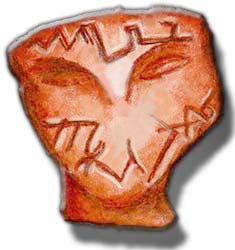

Did
the Balkan-Danube script possess a merely visual value or did it also
have a phonetic one? Did it therefore express the sounds of an oral
language in graphic signs? Today the script continues to maintain its
secrets and it is still arguable whether it was made up of pictographic
signs (representing objects or concepts by means of schematic, but quite
realistic, drawings) and ideograms, or whether it associated written
signs to a phonetic structure (in words or syllables). We do not even
know what kind of language these populations actually spoke.
The
proto-European script is probably logico-phonetic; it embodies both
ideograms and signs corresponding to the spoken language. In particular,
the ideographic symbols seem to indicate entire words and are prevalent
both in number and role.
The phonetic component just performed an additional function, indicated
by the small graphic markers (strokes, dots and arches) varying the
root-signs. These markers could have been used to single out either
syllabic segments (as in Egyptian hieroglyphs) or whole syllables (as
in Akkadian cuneiform writing).
Summing
up, the additional small graphic markers are used, when writing a text,
to point out the different grammatical aspects or the implications of
a basic concept expressed by an elementary sign, or else to indicate
the phonetic element (probably a syllabic one) in a language unknown
to us. (Merlini
2002a)
The logical-syllabic systems were more usual in archaic times. The proto-European
one recalls the structure of the first Sumerian pictographic system,
where there are only occasional phonetic (syllabic) values which were
to become dominant in the later Akkadian cuneiform writing (Haarmann,
1997).
